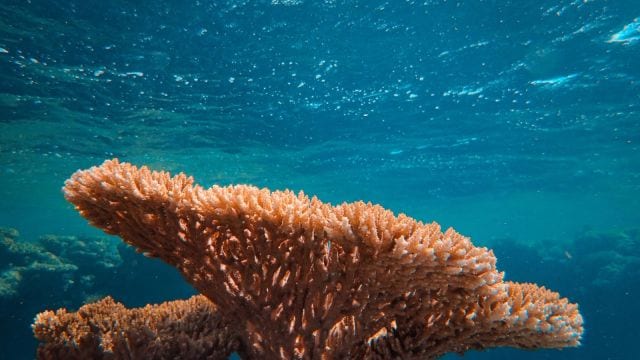How fragile corals at Mumbai’s coast found new home away from Coastal road perils
Four years since the corals' shift (the translocation was undertaken in November 2020), civic officials have said that nearly 97 per cent of the corals are thriving in their new homes.
 Environmentalists have however raised concerns about the BMC's claims as well as the future of the delicate marine species. (Photo Credit: Representational/Canva Image)
Environmentalists have however raised concerns about the BMC's claims as well as the future of the delicate marine species. (Photo Credit: Representational/Canva Image)For Mumbai’s marine enthusiasts and ecologists, the news that initial environmental surveys had given a nod for reclamation works at Worli and Haji Ali under the Mumbai Coastal Road Project (MCRP) came as a rude shock. The move was concerning to them as the proposed reclamation was bound to wipe out the small coral colonies which had been documented at these sites and were coming in the way of the project.
According to the Brihanmumbai Municipal Corporation (BMC), no coral colonies were found when the Environmental Impact Assessment (EIA) was first conducted to execute the Coastal Road work.
However, environmentalists decried the report and approached the High Court and the Mangrove Cell (a specialised body solely dedicated for mangrove management and conservation), stalling the reclamation work.
“Subsequently, we consulted the NIO (National Institute of Oceanography) and the Mangrove Cell who identified corals and finalised the new locations to translocate the corals. Under their guidance, we translocated six coral species from Haji Ali to Navy Nagar and from Worli, the corals were shifted at the same location but outside the influence of the Coastal Road,” senior BMC officials told Express.
Four years since the corals’ shift (the translocation was undertaken in November 2020), civic officials have said that nearly 97 per cent of the corals are thriving in their new homes. Environmentalists have however raised concerns about the BMC’s claims as well as the future of the delicate marine species.
Days ahead of the Coastal Road’s opening, The Indian Express revisits the fight and process to translocate 18 colonies of Mumbai’s delicate marine creatures, their current health and the environmentalists’ worries.
Fight for Mumbai’s corals
The Mumbai coast hosts a tiny population of corals where small colonies of the marine invertebrates have been documented off Marine Drive, Geeta Nagar in Colaba, Haji Ali and Worli. The corals found on rocky patches along the Mumbai coastline are mostly fast-growing and non-reef building corals.
For the many city based marine enthusiasts, these coral reefs were city’s most fragile assets.
Pradip Patade, one of the founders of Marine Life of Mumbai (MLOM), who has been carrying out guided walks along the city’s coasts since 2013 said, “Mumbai’s shoreline is lined with pretty marine creatures, including corals, which were visible during low tides. When I found out about the EIA report, I lodged complaints with the Mangrove Cell.”
In a bid to save them, NGOs moved the High Court, who, citing lacunae in the previous EIA report and taking note of the petitioner’s reports, said the authorities will have to procure permissions under the Wildlife Protection Act 1972.
The BMC then roped in the NIO, Mangrove Cell and environmental consultants to carry out a study of the coral reefs along the Coastal Road Project alignment and demarcate the areas where corals existed. The NIO identified six coral species at Worli and Haji Ali: two species of the Rhizangiidae family (Oulangia and one unidentified species), with colonies documented across 0.251 square metres in Worli; and another species of the Dendrophylliidae family along with Rhizangiidae across 1.1 square foot area at Haji Ali.
Eighty workers, three days, one mission
On October 29, 2020, after a long drawn process, the BMC finally got a green light from the Principal Chief Conservator of Forests (Wildlife), Nagpur, to translocate the corals. With the aim to save the identified corals from the impact of the Coastal Road, the colonies at Haji Ali were translocated to Navy Nagar, while at Worli, few were translocated some distance away from the construction site and some loose rocks at Navy Nagar.
The entire process — conducted by eighty experts which included environmental consultants, officials from NIO, BMC, Mangrove Cell, Larsen & Toubro as well as HCC under scientific care — took three days.
According to experts, since the corals at Haji Ali were on small rocks, they were easier to shift. The corals at Worli were on plated rocks that had to be cut.
Vivek Kulkarni, an independent coastal ecologist who was appointed by BMC to overlook the safety of marine biodiversity during the project, said, “As against lifting small rocks, larger rocks have to be cut and drilled, which is not simple. We had to make sure that the drilling was not done too close to the corals and that the vibrations were not affecting them.”
To check their survival rate, the NIO and other stakeholders only undertook initial cutting. Kulkarni added, “We noted that the corals had survived the vibrations. Following that, we began the drilling process.”
After cutting the rocks, the health of the corals were observed and stabilised at special temperatures for 16 to 30 hours before their translocation near the Shiva Temple at Navy Nagar — a location, which being under the Indian
Navy, was likely to offer protection and no disturbance to its new residents.
Each rock was tagged with the details and the NIO, alongside other stakeholders, undertook monthly inspections over the next 12 months.
Their survival
Three months after the translocation was completed, ecologists discovered that the corals were not only thriving but had also started colonising with the new corals and thus, were growing. Kulkarni said, “We were observing a survival rate of 110 per cent.”
A year later — in 2022 — NIO researchers published a study that stated nearly 92 per cent of coral colonies translocated from Haji Ali were found to be surviving. Speaking to The Indian Express, meanwhile, BMC officials from the Coastal Road department said that around 97 per cent of the total corals from both, Haji Ali and Worli, are currently thriving.
Even so, marine ecologists from the city have raised concerns over these claims and the corals’ future.
The concerns
Patade questioned why the NIO had not provided details about the corals’ health in public domain. “The NIO published only one paper, that too in a scientific journal, in 2022 about the survival rate of the corals (Pseudosiderastrea tayamai). Ideally, the NIO should have furnished the report about the results of relocation of all species in the public domain. The entire shoreline in Mumbai has scattered coral colonies, yet they have only relocated the corals from Haji Ali and Worli. What about the corals at the other locations? While undertaking the reclamation, they must have already killed those corals,” Patade said.
Meanwhile, Stalin D from Sagarshakti, who was one of the petitioners in the HC, raised questions on whether the corals, while living now, will continue to survive in the future.
“Because of the Coastal Road, the temperature of the waters will likely increase. There is a scientific possibility that the corals — being very delicate — may not survive this, even if they are surviving now.”







